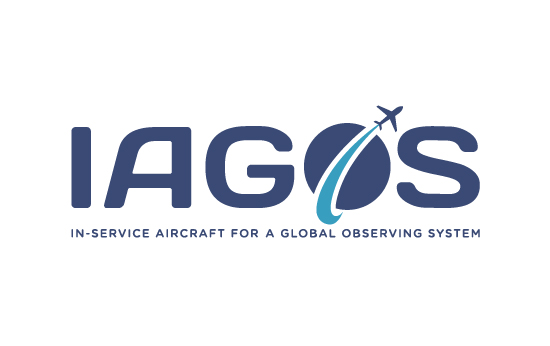IAGOS – short for ‘In-service Aircraft for a Global Observing System’, is one of the ‘Landmark Research Infrastructures’ of the ‘European Strategy Forum on Research Infrastructures’ (ESFRI). The project has been running with the long-term support of the Federal Ministry of Education and Research (BMBF) since 1994. Instruments on board commercial aircraft all over the world measure long-lived carbon dioxide and short-lived greenhouse gases such as ozone, water vapour and methane, the reactive trace gases carbon monoxide and nitrogen oxides, as well as aerosol particles. The FZJ is responsible for the components water vapour, nitrogen oxides and aerosol particles.
The measurement data collected is automatically transmitted to the central database of the CNRS (Centre National de la Recherche Scientifique) research centre in Toulouse after each flight. It is freely and openly accessible for global research and is currently used by around 300 organisations worldwide. The data help researchers to gain new insights into climate development and the composition of the atmosphere, to identify long-term changes, to refine climate models and to improve weather forecasts.
A total of ten aircraft from eight airlines worldwide are currently equipped with the IAGOS system.
Data and Facts: IAGOS is organised as an international non-profit organisation (IAGOS-AISBL) based in Brussels. Its members are leading research organisations, universities and meteorological services from Germany, France and the United Kingdom. IAGOS is building on the scientific and technological experience gained from the MOZAIC (Measurement of Ozone and Water Vapour on Airbus in-service Aircraft) and CARIBIC (Civil Aircraft for the Regular Investigation of the Atmosphere Based on an Instrument Container) research projects. With MOZAIC as its basis, which was funded by the European Commission between 1993 and 2004 as part of the 4th and 5th framework programmes, the research infrastructure can now look back on data series from over 30 years of measurements and more than 35.000 flights.
Information on Financing/Funding of the RI: IAGOS is sustained by France, Germany and the UK through national projects funded by the BMBF (IAGOS-D), CNRS (IAGOS-F) and NERC (IAGOS-UK), in addition to the institutional resources of the partners.
The airlines associated with IAGOS make a significant contribution to the operation of the infrastructure by providing their technical expertise in the installation and deployment of the equipment and by foregoing the additional fuel costs incurred in transporting the IAGOS-CORE installation.
Infrastructure
Partners / Cooperationen / Network
- Centre National de la Recherche Scientifique, Paris, France
- Max-Planck-Gesellschaft zur Förderung der Wissenschaften e.V., Munich, Germany
- Météo France, Toulouse, France
- University of Manchester, Manchester, United Kingdom
- Deutsches Zentrum für Luft- und Raumfahrt e.V., Cologne, Germany
- Leibniz-Institut für Troposphärenforschung e.V., Leipzig, Germany
- Karlsruher Institut für Technologie, Karlsruhe, Germany
Testimonials
Connected Projekte
Contact
Prof. Dr. Andreas Petzold
Leading Scientist Head of department "Global Observation"
- Institute of Climate and Energy Systems (ICE)
- Troposphere (ICE-3)
Room 3048
Dr. Ulrich Bundke
Senior Scientist Technical Director IAGOS Principal Investigator: Aerosols
- Institute of Climate and Energy Systems (ICE)
- Troposphere (ICE-3)
Room 3049b
Dr. Susanne Rohs
Senior Scientist Principal Investigator: Water Vapour
- Institute of Climate and Energy Systems (ICE)
- Troposphere (ICE-3)
Room R 3050
Dr. Christoph Mahnke
Senior Scientist Principal Investigator: Nitrogen Oxides
- Institute of Climate and Energy Systems (ICE)
- Troposphere (ICE-3)
Room 3046
Reference publications
Petzold, A., Thouret, V., Gerbig, C., Zahn, A., Brenninkmeijer, C. A. M., Gallagher, M., Hermann, M., Pontaud, M., Ziereis, H., Boulanger, D., Marshall, J., Nédélec, P., Smit, H. G. J., Frieß, U., Flaud, J.-M., Wahner, A., Cammas, J.-P., Volz-Thomas, A., and IAGOS-Team: Global-Scale Atmosphere Monitoring by In-Service Aircraft – Current Achievements and Future Prospects of the European Research Infrastructure IAGOS, Tellus B, 67, 28452, doi: https://doi.org/10.3402/tellusb.v67.28452, 2015.
Li, Y., Mahnke, C., Rohs, S., Bundke, U., Spelten, N., Dekoutsidis, G., Groß, S., Voigt, C., Schumann, U., Petzold, A., and Krämer, M.: Upper-tropospheric slightly ice-subsaturated regions: frequency of occurrence and statistical evidence for the appearance of contrail cirrus, Atmos. Chem. Phys., 23, 2251-2271, doi: https://doi.org/10.5194/acp-23-2251-2023, 2023.
Mahnke, C., Gomes, R., Bundke, U., Berg, M., Ziereis, H., Sharma, M., Righi, M., Hendricks, J., Zahn, A., Wahner, A., and Petzold, A.: Properties and Processing of Aviation Exhaust Aerosol at Cruise Altitude Observed from the IAGOS-CARIBIC Flying Laboratory, Environ. Sci. Technol, doi: https://doi.org/10.1021/acs.est.3c09728, 2024.
Petzold, A., Neis, P., Rütimann, M., Rohs, S., Berkes, F., Smit, H. G. J., Krämer, M., Spelten, N., Spichtinger, P., Nédélec, P., and Wahner, A.: Ice-supersaturated air masses in the northern mid-latitudes from regular in situ observations by passenger aircraft: vertical distribution, seasonality and tropospheric fingerprint, Atmos. Chem. Phys., 20, 8157-8179, doi: https://doi.org/10.5194/acp-20-8157-2020, 2020.








